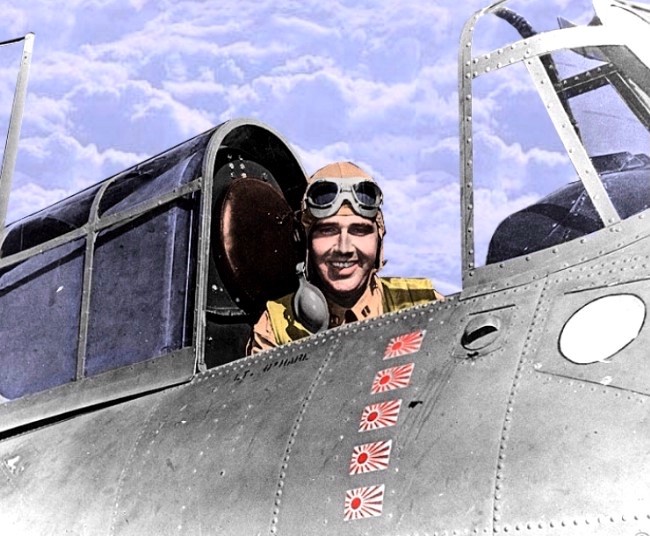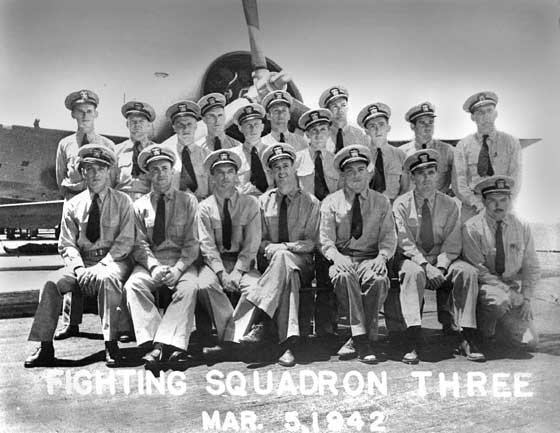 Sometimes greatness runs in families. This time, the O'Hare family. From AcePilots,
Sometimes greatness runs in families. This time, the O'Hare family. From AcePilots, Edward H. O'Hare was born on March 13, 1914 in St. Louis, the son of "E.J." O'Hare, a wealthy businessman and attorney. His parents sent him to Western Military Academy (WMA) at age 13, where he pursued an interest in marksmanship, becoming president of the rifle club. In 1932, he graduated from WMA, and in 1933 went on to the US Naval Academy. Many of his classmates from both schools died in WWII.Hey, here is an idea worth bringing back.
Upon his graduation from Annapolis he received choice duty on the USS New Mexico (BB-40).
While he was interested in aviation, all new officers had to spend two years in surface ships, before specializing in aviation or submarines.Though not in the military, his father showed the courage he gave to his son.
In November, his father was gunned down by Al Capone's gunmen, most likely because he had given the government information useful in its prosecution of Capone. The gangland-style murder made big headlines, and the newspapers printed numerous speculations on the circumstances of the murder.Skip to WWII.
On February 20, 1942, Butch O'Hare demonstrated in real life, and when it counted most, the fighting skills he had mastered. The carrier Lexington had been assigned the dangerous task of penetrating enemy-held waters north of New Ireland. From there her planes were to make a strike at Japanese shipping in the harbor at Rabaul. Unfortunately, while still 400 miles from Rabaul, the Lexington was discovered by a giant four-engine Kawanishi flying boat. Lieutenant Commander John Thach, skipper of the Lexington's Wildcat fighters, shot down the Japanese "Snooper," but not before it had radioed the carrier's position. That afternoon Commander Thach led six Wildcats into the air to intercept nine twin-engine enemy bombers. In a determined attack each of the Wildcats destroyed a bomber and damaged two more. The ship's anti-aircraft guns finished off the rest. In the meantime, nine more Japanese bombers were reported on the way. Six Wildcats, one of them piloted by Butch O'Hare, roared off the Lexington's deck to stop them. O'Hare and his wingman spotted the V formation of bombers first and dived to try to head them off. The other F4F pilots were too far away to reach most of the enemy planes before they released their bombs. As if this weren't bad enough, O'Hare's wingman discovered his guns were jammed. He was forced to turn away. Butch O'Hare stood alone between the Lexington and the bombers.More details at AcePilots (and yes, O'Hare Airport).O'Hare didn't hesitate. Full throttle, he roared into the enemy formation. While tracers from the concentrated fire of the nine bombers streaked around him, he took careful aim at the starboard engine of the last plane in the V and squeezed his trigger. Slugs from the Wildcats six .50-caliber guns ripped into the Japanese bomber's wing and the engine literally jumped out of its mountings. The bomber spun crazily toward the sea as O'Hare's guns tore up another enemy plane. Then he ducked to the other side of the formation and smashed the port engine of the last Japanese plane there.
One by one he attacked the oncoming bombers until five had been downed. Commander Thach later reported that at one point he saw three of the bombers falling in flames at the same time. By now Thach and the other pilots had joined the fight. This was lucky because O'Hare was out of ammunition. The Wildcats took care of several more bombers and Lexington managed to evade the few bombs that were released. It was an amazing example of daring and shooting skill. Afterward Thach figured out that Butch O'Hare had used only sixty rounds of ammunition for each plane he destroyed. He had probably saved his ship. He was promoted to Lieutenant Commander and awarded the highest decoration of his country, the Congressional Medal of Honor.
With his Medal of Honor presentation, bond tours, and other commitments, Butch was out of combat from early 1942 until late 1943. On October 10, 1943, he flew with VF-6 in the air strikes against Wake Island. On this mission Alex Vraciu, the future ace, was Butch's section leader. Both O'Hare and Vraciu scored that day.
...
In November, 1943, the Americans landed in the Gilberts (Tarawa and Makin), and the carriers were covering the landings. Equipped with the new F6F Hellcats, the US fighter pilots owned the skies, and could protect the Navy's warships from Japanese aircraft. From their bases in the Marianas, the Japanese quickly developed tactics to send torpedo-armed Bettys on night missions against the US carriers. In late November they launched these low-altitude strikes almost nightly, in a deadly attempt to get at Enterprise and other American ships.
Ed O'Hare, now Enterprise Commander - Air Group (CAG), was deeply involved in developing ad hoc counter-tactics, the first carrier-based night fighter operations of the US Navy. As the primitive radars were very bulky, they were carried on the Enterprise, on the fairly large Avenger in profile TBF Avengers, but not on the smaller and faster Hellcats. The plan required the ship's Fighter Director Officer (FDO) to spot the incoming Bettys at a distance and send the Avengers and Hellcats toward them. The radar-equipped Avengers would then lead the Hellcats into position behind the incoming Bettys, close enough for the Hellcat pilots to spot visually the Bettys blue exhaust flames. Finally, the Hellcats would close in and shoot down the torpedo-carrying bombers. All the planes on both sides would be flying at low level. The plan was experimental, complicated, risky, and necessary - if the Bettys were to be thwarted.
The night of November 27, 1943 was the first combat test of the plan, following an earlier mission that hadn't contacted the Japs. The 'Black Panthers', as the night fighters were dubbed, included two sections of three planes. Both included two Hellcats and one Avenger. Butch led his section from his F6F, Warren Skon flew on his wing; Lt. Cdr. Phillips piloted the TBF with radarman Hazen Rand and gunner Alvin Kernan crewing the plane. (Alvin Kernan's memoirs of his experiences as an enlisted man on US Navy carrier during WWII, Crossing the Line: A Bluejacket's World War II Odyssey, describe this night in detail, from the perspective of the man who fired the Avenger's gun seconds before Butch disappeared.
All you guys happy with production line promotion systems, I want you to note: graduated from Annapolis in 1937. By 1943, six years later, he was CAG of Air Group SIX off the USS ENTERPRISE (CV-6) - at age 29. Fullbore.
 Hat tip The Corner (though they got some details wrong).
Hat tip The Corner (though they got some details wrong).
No comments:
Post a Comment